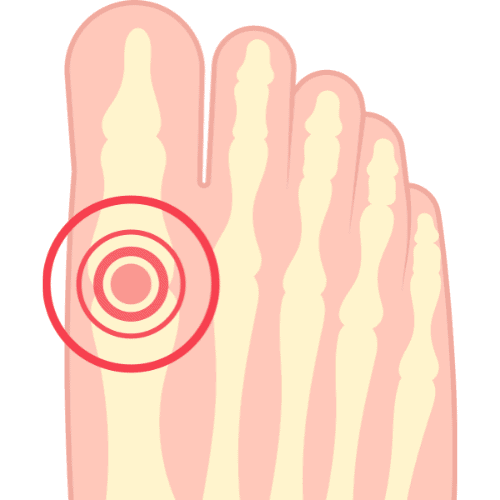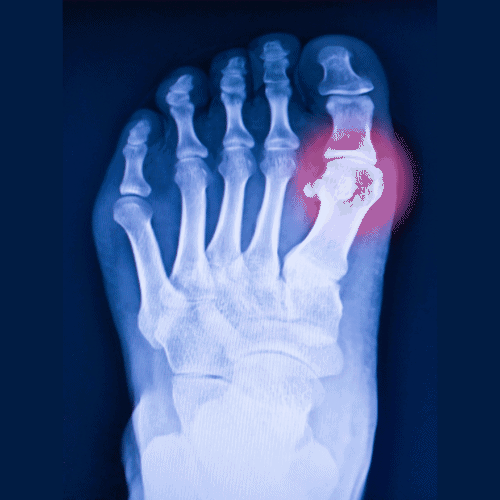Every step you take, a sharp pain shoots through your big toe. It’s not just a fleeting discomfort; it’s a constant reminder of the joint pain you’re experiencing. While many might dismiss it as a minor inconvenience, for those who suffer, it’s a daily challenge. But why does this pain occur? And more importantly, how can you find relief?
As someone who has extensively researched various health topics and worked closely with experts in the field of orthopedics, I understand the frustration and desperation that comes with such ailments. In this article, we’ll delve deep into the causes, symptoms, and most effective treatments for joint pain in the big toe.
Whether you’re a long-time sufferer or someone just starting to notice discomfort, this guide is tailored for you.
- Summary
- Anatomy of the Big Toe
- Common Causes of Joint Pain in the Big Toe
- Symptoms Associated With Big Toe Joint Pain
- Diagnostic Procedures
- Treatment Options
- Prevention and Self-Care
- FAQ Section
- What causes sudden sharp pain in the big toe joint?
- How is gout different from other forms of arthritis?
- Can wearing high heels cause joint pain in the big toe?
- How long does joint pain in the big toe last?
- Are there any home remedies for relief from big toe joint pain?
- When should I see a doctor for my big toe joint pain?
- Conclusion
Summary
Common causes include wear and tear, injuries, and genetic factors. Treatment options range from pain relievers and physical therapy to surgical interventions.
Early diagnosis and treatment can help manage symptoms and improve quality of life.
Anatomy of the Big Toe

Structure and Functions
Otherwise known as the hallux, the big toe is one of five digits on the front of the foot. It comprises two toe bones – the distal and proximal phalanges- comprising the hallux’s interphalangeal joint. The metatarsophalangeal joint (MTPJ) is where the first long bone of the foot (metatarsal) meets the first bone of the toe (phalanx). Its primary function is to bend and grip the ground and to accommodate foot flexibility when walking.
The MTPJ is surrounded by important structures that hold it in place and prevent it from dislocating. Together these structures are referred to as the “plantar complex.”
- Collateral ligaments – These ligaments are on each side of the big toe, and they connect the phalanx bone to the metatarsal and prevent it from going too far side-to-side.
- Flexor hallucis brevis – Flexor hallucis brevis is a small intrinsic foot muscle within the sole. It runs beneath the first metatarsal bone, connects to the phalanx, and provides strength and stability to the big toe during push-off motions.
- Plantar plate – The plantar plate is a thick, fibrous tissue under the MTP joint that keeps the toes straight and in place and prevents the big toe from bending too far (dorsiflexion).
- Sesamoids – These two small bones are enveloped in the flexor hallucis tendon and help it to move more easily. In addition, the sesamoids provide stability to the MTP joint by helping to bear the weight placed on the forefoot.
The muscles and ligaments attached to the ï¬rst MTPJ play a vital role in normal and abnormal functions. Along with the little toe, the big toe helps maintain the body’s balance while standing. The big toe also provides additional leverage to the foot when it pushes off the ground during walking, running, or pedaling.
Common Causes of Joint Pain in the Big Toe

Hallux rigidus likely develops because the big toe joint experiences a lot of stress. Most cases of hallux rigidus develop naturally over time without an obvious cause, but it’s most often attributed to the normal wear and tear on the joints as a person ages and doubles the body weight pressure on the MTP joint. At the same time, it can also contribute to cartilage damage.
Arthritis
Osteoarthritis and rheumatoid arthritis are two distinct types of arthritis. The main difference between them is the cause behind their respective symptoms – Osteoarthritis is caused by mechanical wear and tear on joints, while rheumatoid arthritis is an autoimmune disease in which the body’s immune system attacks the body’s joints.
These two conditions contribute largely to big toe joint pain. Both cause pain and stiffness in the toe joint, making walking difficult since this joint moves every time you walk. Both also cause inflammation, causing swelling around the toe joint and leading to cartilage damage.
Gout
Gout is a common and complex type of inflammatory arthritis that causes joint pain and swelling, usually as flares that last up to two weeks. It’s caused by hyperuricemia, a condition that happens when there is too much uric acid in the body. The body produces uric acid when it breaks down purines found in your body and the foods you eat.
Gout flares often begin in the big toe (or a lower limb) and often have small, sharp crystals in and around the joints caused by the uric acid buildup. Eating too much red meat and shellfish and drinking either highly-sweetened or alcoholic beverages can spike uric acid levels and increase the risk of gout.
Bunions
Bunions are bony bumps on the joint at the proximal phalanx or base of the big toe. These bumps form when some of the bones in the front part of your foot move out of place and cause the tip of your big toe to get pulled toward the smaller toes, forcing the joint at the proximal phalanx to protrude.
For people who tend to have bunions, the best prevention tip is to avoid excessively tight shoes and opt for ones with wider insteps and softer soles. Wearing high-heeled shoes can also worsen bunions and cause deformity.
Other Injuries and Trauma
Injuries also play a part in big toe joint pain. Injuries like stubbing your toe or turf toes (sprained toes) cause mild to severe toe joint pain, swelling, bruising, and affect mobility. Athletes and physically active people often experience turf toes, especially football players playing on artificial grass with less shock absorbance.
The RICE method is a self-care technique that helps reduce swelling, relieve pain, and speed healing. It stands for Rest, Ice, Compression, and Elevation and is often applied as an immediate treatment for minor injuries like turf toes.
- Rest – Avoid intense physical activity that can aggravate joint pain and other symptoms.
- Ice – Apply an ice pack on the afflicted joint. Don’t apply the ice directly on the affected area.
- Compression – Wrap the affected joint part firmly with a bandage or compression sleeve.
- Elevation – Elevate the affected body part above the level of your heart to decrease swelling and joint pain.
Symptoms Associated With Big Toe Joint Pain
Sharp Pain
The sharp pain that comes with big toe joint pain is usually worse at night and flares up in the first few steps in the morning. Arthritis and gout are usually behind this pain, but stress and damage to the big toe joint can also be contributing factors. In some cases, the pain can also extend to other toes.
Pain In the Toe Joint During Mobility
Movement can trigger big toe joint pain, especially while walking. Walking rapidly or wearing tight, uncomfortable footwear can also exacerbate the pain and extend it to the foot’s arch. Apart from arthritis, bunions and other toe-related injuries can cause strained and painful walking.
Burning Sensation
Apart from the sharp pain, you may develop a burning sensation over time, a sign of nerve pain or neuropathy.
Diagnostic Procedures
Physical Examination
Your attending healthcare provider/physician will talk to you about your general health and toe joint pain symptoms and ask you to describe how you injured your toe.
During the physical examination of your foot, your doctor will check for things like swelling, bruising, and the range of motion of your MTP joint to look for any problems that could be behind the pain.
Imaging Tests

Imaging tests can help draw a more accurate diagnosis. These include:
- X-rays – The doctor may order X-rays to assess the location and extent of any damage, deformities, and other internal issues in your toe, like bunions or bone spurs. X-rays are best done standing and putting added weight on the affected foot.
- Ultrasounds – Ultrasound image is highly sensitive at picking up early joint changes associated with arthritic pain, assessing for any tears in your ligaments or tendons which could be responsible for the pain. Here, the doctor will place an ultrasound probe on your toe to take pictures of the joint and surrounding tissue.
- Magnetic resonance imaging scan (MRI) – While not often used to test big toe joint pains, MRIs can create better images of soft tissue and reveal any injuries in the soft tissues and cartilage.
Treatment Options
Medications & Supplements
Various studies show that over-the-counter medications are effective at helping improve pain and physical function in knee/hip osteoarthritis patients. Over-the-counter pain relievers and prescription drugs such as ibuprofen (Advil), acetaminophen (Tylenol), and duloxetine (Cymbalta) have been effective for people who have mild to moderate flare-ups of joint pain.
Dietary supplements help manage and prevent factors that could trigger joint pain. Physio Flex Pro is a supplement complex that can effectively restore and promote joint health and provide optimal pain relief, flexibility, and maximum comfort. It contains anti-inflammatory ingredients, including glucosamine, hyaluronic acid, and curcuminoids, which all help promote joint health.
Physical Therapy
Physical therapists prescribe exercise plans for big toe joint pain, as with joint-related inflammations. One study shows that stretching strengthens the muscles around affected joints and controls joint swelling and pain.
One particular toe exercise is the big toe extension stretch. The goal is to be able to stretch the big toe at a 90-degree angle toward your ankle. Here’s how you can do this exercise:
- While sitting down, raise the affected foot on your other knee.
- Hold the heel in one hand and pull the big toe with the other hand toward the ankle. Do this until you feel a gentle stretch along the bottom of your foot.
- Stretch for at least 15 to 30 seconds.
Another sitting-down exercise you can try is the marble pickup exercise. You can use marbles, dice, or small stones for this exercise:
- Put 10-20 marbles in front of you on one side of the chair. You can put them either in bowls or a shallow box.
- While sitting down, use the toes of the affected foot to grab one marble and move it to the other side of the chair. Do this one at a time until you’ve moved all the marbles.
- Once done, return the marbles one by one again with your toes to their old spot.
Surgical Interventions
In most cases, surgery isn’t necessary to treat big-toe arthritis and is often a last resort if all other treatments fail.
- Cheilectomy -A big toe cheilectomy is an operation to remove a bony lump on top of the main joint to give your toe more room to bend and stop painful flare-ups.
- Osteotomy – A surgical procedure that cuts and reshapes the parts of the big toe in the foot to relieve pressure from deformity or an injury.
- Arthroplasty – Otherwise known as joint replacement surgery. Here, the surgeon will replace the damaged bone in your MTP joint with an artificial joint or donor tissue between the joint ends.
- Arthrodesis – Often reserved for more severe cases, the surgeon will remove damaged cartilage and fuse the bones in the joint together. However, this procedure may limit your ability to move your big toe.
Prevention and Self-Care
Footwear Recommendations
Proper and comfortable footwear can prevent injuries, protect against joint damage, bunions, and pulled muscles and tendons, and help stop slips and falls. Shoes with a rocker sole are ideal for people with big toe arthritis, neuromas, and midfoot arthritis by offloading pressure on your forefoot.
Avoid wearing high heels and extremely tight shoes.
Lifestyle Changes
Maintaining a moderate body weight can help prevent inflammation or relieve joint pressure. A healthy, anti-inflammatory diet paired with regular low-impact exercise can promote weight loss and benefit joint health in the long run.
FAQ Section
What causes sudden sharp pain in the big toe joint?
The small, sharp crystals in and around the joints caused by the uric acid buildup cause sharp pain.
How is gout different from other forms of arthritis?
A uric acid buildup causes gout. Osteoarthritis is caused by mechanical wear and tear on joints, while rheumatoid arthritis is an autoimmune disease in which the body’s immune system attacks the body’s joints.Â
Can wearing high heels cause joint pain in the big toe?
Yes, wearing high-heeled shoes can cause joint pain and exacerbate it if you already have it.Â
How long does joint pain in the big toe last?
Hallux rigidus can last minutes or hours and even extend for a few days.
Are there any home remedies for relief from big toe joint pain?
You can apply the RICE method on the affected toe. Another good home treatment is a contrast bath, switching between hot and cold water for 30 seconds each to relieve inflammation.
When should I see a doctor for my big toe joint pain?
Ideally, you should see a doctor if the pain hasn’t subsided even with home treatments or if you’re already unable to walk/move because of it.Â
Conclusion
Hallux rigidus can be an excruciatingly painful condition that can greatly disrupt your productivity and quality of living. Thankfully, with early and proper treatment, you can reduce pain and other symptoms to restore mobility in no time.
If you’re experiencing big toe joint pain or any joint-related problems, waste no time and consult your healthcare provider immediately to discuss options and help apply proper treatment.
Disclaimer: this article does not constitute or replace medical advice. If you have an emergency or a serious medical question, please contact a medical professional or call 911 immediately. To see our full medical disclaimer, visit our Terms of Use page.








